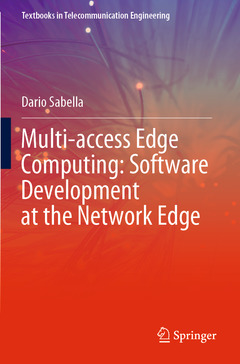Description
Multi-access Edge Computing: Software Development at the Network Edge, 1st ed. 2021
Textbooks in Telecommunication Engineering Series
Language: English
Subjects for Multi-access Edge Computing: Software Development at the...:
Multi-access Edge Computing: Software Development at the Network Edge
Publication date: 08-2022
409 p. · 15.5x23.5 cm · Paperback
Publication date: 08-2022
409 p. · 15.5x23.5 cm · Paperback
Multi-access Edge Computing: Software Development at the Network Edge
Publication date: 08-2021
409 p. · 15.5x23.5 cm · Hardback
Publication date: 08-2021
409 p. · 15.5x23.5 cm · Hardback
Description
/li>Contents
/li>Biography
/li>Comment
/li>
The textbook covers the main aspects of Edge Computing, from a thorough look at the technology to the standards and industry associations working in the field. The book is conceived as a textbook for graduate students but also functions as a working guide for developers, engineers, and researchers. The book aims not only at providing a comprehensive technology and standard reference overview for students, but also useful research insights and practical exercises for edge software developers and investigators in the area (and for students looking to apply their skills). A particular emphasis is given Multi-access Edge Computing (MEC) as defined in European Telecommunications Standards Institute (ETSI), in relationship with other standard organizations like 3GPP, thus in alignment with the recent industry efforts to produce harmonized standards for edge computing leveraging both ETSI ISG MEC and 3GPP specifications. Practical examples of Edge Computing implementation from industry groups, associations, companies and edge developers, complete the book and make it useful for students entering the field. The book includes exercises, examples, and quizzes throughout.
Introduction.- Principles of Edge Computing, Fog and Cloud Computing.- Standards and industry associations around Edge Computing.- Multi-access Edge Computing (MEC): standards on edge platforms.- Multi-access Edge Computing (MEC): standards on edge services.- Radio Network Information API.- MEC in Network Functions Virtualization (NFV) deployments.- Edge Computing in 5G networks.- Mobility aspects: radio and computation perspectives.- Software development for Edge Computing.- MEC in action: compliance, testing, proof-of-concepts.- APIs for web and mobile applications.- MEC software resources.- Conclusion.
DARIO SABELLA works with Intel as Senior Manager Standards and Research, driving new technologies and edge cloud innovation for advanced systems, involved in ecosystem engagement and coordinating internal alignment on edge computing across standards and industry groups. In February 2021 has been elected as Chairman of ETSI MEC (Multi-access Edge Computing), while from 2019 he was serving as vice-chairman, previously Lead of Industry Groups, and from 2015 vice-chair of IEG WG. Since 2017 he is also delegate of 5GAA (5G Automotive Association). Before 2017 he worked in TIM (Telecom Italia group), as responsible in various research, experimental and operational activities on OFDMA technologies (WiMAX, LTE, 5G). Author of several publications (40+) and patents (30+) in the field of wireless communications, energy efficiency and edge computing, Dario is IEEE senior member and has also organized several international workshops and conferences. From January 2021 Dario is also Innovation Manager of the EU funded 6G flagship Hexa-X project.
Provides a detailed description of Edge Computing technologies as introduced by ETSI MEC and an overview of other Standards and industry associations working in the area Capitalizes on the author’s extensive background in the industry to provide significant reference material for researchers, students and professionals, but also mobile application developers, and system integrators Includes helpful references, practical examples, graphical code, quizzes, and online ancillaries such as slides, exercises and models solutions
© 2024 LAVOISIER S.A.S.
These books may interest you

Mobile Edge Computing 31.64 €



